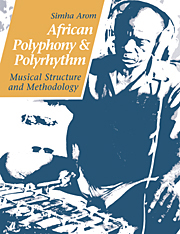Book contents
- Frontmatter
- Contents
- List of illustrations
- Foreword by György Ligeti
- Preface
- Acknowledgements
- BOOK I THE MUSIC OF THE CENTRAL AFRICAN REPUBLIC
- BOOK II AFRICAN POLYPHONIC MUSIC
- BOOK III TECHNICAL TOOLS: METHODS OF RECORDING POLYPHONIC MUSIC FOR TRANSCRIPTION
- BOOK IV THEORETICAL TOOLS
- BOOK V THE ORGANISATION OF TIME IN AFRICAN MUSIC
- BOOK VI STRUCTURAL PRINCIPLES AND THEIR APPLICATION
- 1 Typology
- 2 Analytical notions
- 3 Strict polyrhythmics
- 4 Polyrhythmics as a way to polyphony: Hocket
- 5 Polyphony produced by melodic instruments
- 6 The association of polyphony and polyrhythmics
- Conclusion
- Bibliography
6 - The association of polyphony and polyrhythmics
Published online by Cambridge University Press: 27 January 2010
- Frontmatter
- Contents
- List of illustrations
- Foreword by György Ligeti
- Preface
- Acknowledgements
- BOOK I THE MUSIC OF THE CENTRAL AFRICAN REPUBLIC
- BOOK II AFRICAN POLYPHONIC MUSIC
- BOOK III TECHNICAL TOOLS: METHODS OF RECORDING POLYPHONIC MUSIC FOR TRANSCRIPTION
- BOOK IV THEORETICAL TOOLS
- BOOK V THE ORGANISATION OF TIME IN AFRICAN MUSIC
- BOOK VI STRUCTURAL PRINCIPLES AND THEIR APPLICATION
- 1 Typology
- 2 Analytical notions
- 3 Strict polyrhythmics
- 4 Polyrhythmics as a way to polyphony: Hocket
- 5 Polyphony produced by melodic instruments
- 6 The association of polyphony and polyrhythmics
- Conclusion
- Bibliography
Summary
GENERAL CHARACTERISTICS
Strict polyrhythmics and polyphony produced by melodic instruments have thus far been examined separately and out of context so as to give us a better view of how each works. In the musical practice of this part of Africa, however, the polyphony produced by melodic instruments always rests on a rhythmic or polyrhythmic substructure. We must therefore now consider the principles which govern the conjunction of these two components within a musical construction. We will do so by returning to the pieces which we have examined in partial form in the preceding chapters.
We may recall that the polyphony performed by melodic instruments itself acts as a support and a modal, periodic, and metric framework for vocal music.
There are several ways of performing such vocal music:
(1) It may be performed entirely by a soloist
(2) It may be performed by a soloist, backed by a choir, although the choral part may on occasion be assigned to a single person
(3) It may be performed responsorially in two parts, the first of which is sung by the soloist and may display variations, and the second of which is an invariant response sung by the choir.
In every case, the solo part is sung by the instrumental musician himself or, in the case of music performed with two melodic instruments, by one of the two musicians (usually the most experienced one). While the solo part is subject to variation, the response by the choir or any individual singer remains unchanged. It acts as an extremely stable, if not perfectly strict melodic and rhythmic ostinato.
- Type
- Chapter
- Information
- African Polyphony and PolyrhythmMusical Structure and Methodology, pp. 619 - 654Publisher: Cambridge University PressPrint publication year: 1991



